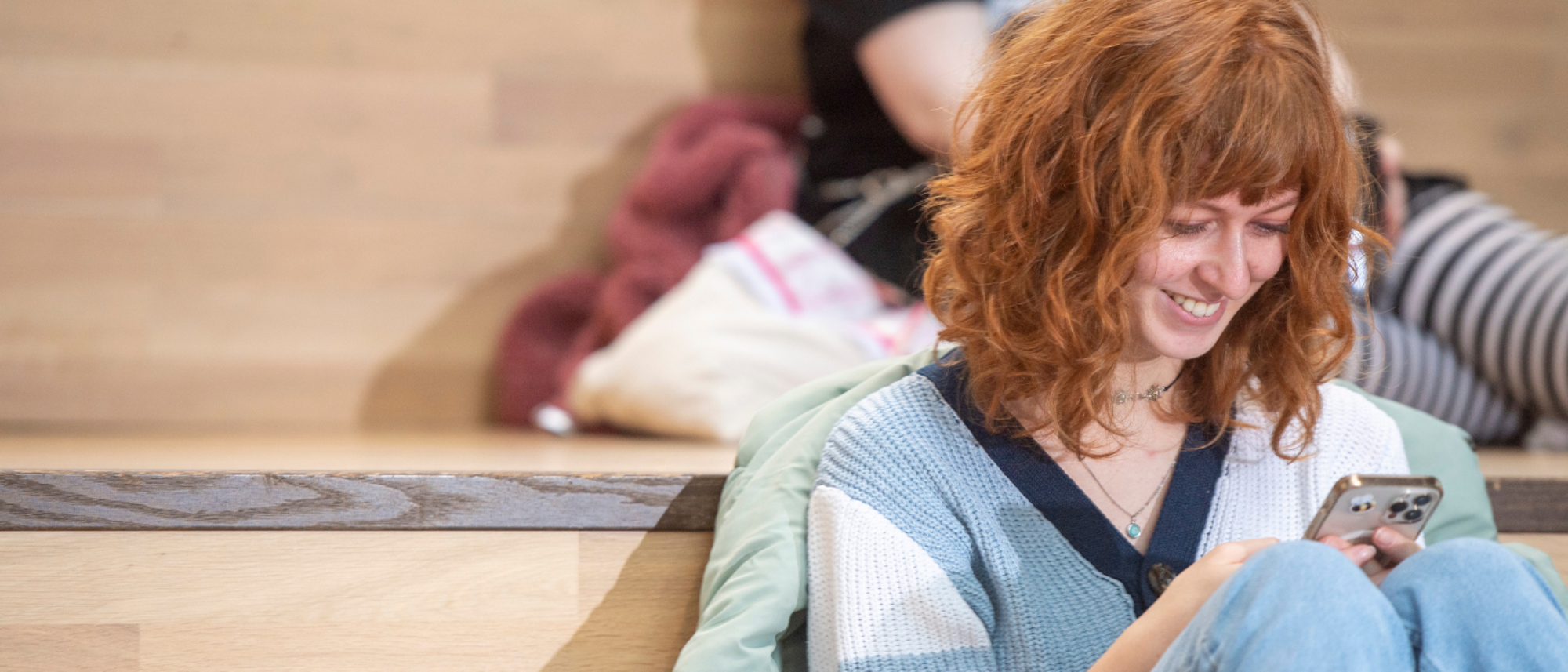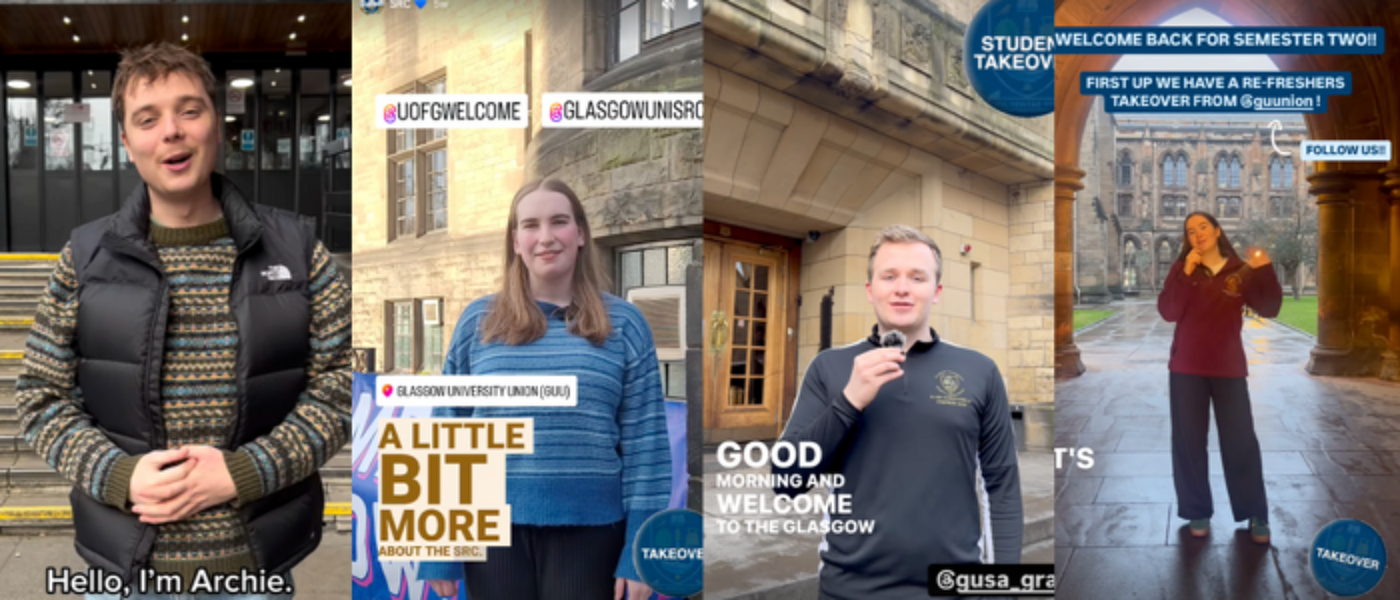
Here are some things to consider when creating engaging content, including; copywriting, storytelling, accessibility, inclusivity, and submitting content to our channels
Contact
Submitting Content to UofG Central Channels
- Do you have something to share on the main UofG social media Twitter channel? Email us!
Social Media Copywriting and Storytelling Tips
- Write for your audience’s needs. What are they most interested in? How can you add value for them with your social media content?
- Start a conversation and reply to all comments and messages. This is the social part of social media. Asking followers about their experiences, ideas, memories will help them feel valued and part of your community. You want to encourage the audience to engage through comments, likes and shares.
- Adjust your tone of voice for each platform and purpose. Younger audiences on TikTok and Instagram require a more informal, playful and friendly tone. Professional audiences on LinkedIn require more formality, but also respond well to high-emotion posts. Adopt a platform specific approach. Your audience will be different across various platforms and what works best for one platform may not work for another.
- Promote your values. Social media use is significant in setting the tone on campus. Promote and represent the kind of culture your school aims to cultivate by making your mission and values known. It’s a way to show students (past, present, and future) that you share values with them.
- Promoting staff and students’ achievements gives your current students, alumni and industry partners a chance to understand how active your school is and celebrate with you.
- Use data/analytics. Researching what has worked before is one of the best ways to write successful posts - using data and evidence to improve your content. Compare content written in different ways, or with a different image choice or across different channels and see which performed best.
- Include an inspiring call to action. A call to action is the part of your copy that tells the audience what to do. If it’s written well, it will tap into their desires and emotions, and make them feel inspired to do the action.
Community Engagement
- Build and empower your own social media community. Identify social media active members of staff and research students in your School. Follow their channels and engage with their content. Encourage them to share content for your channel and to tag you in their posts. The mention should be part of a sentence rather than listed at the end of the content. The more engagement you get, the more social media platforms push your content out to larger numbers of our followers.
- Develop a student takeover programme. Student takeovers are a powerful view into authentic campus life, whether you’re sharing the work of one dedicated creator or are sharing user-generated content from various community members. Check out the UoG social media ambassador programme.
- Engage with your audience by responding to comments, messages, and inquiries in a timely manner.
- Collaborate with influencers, industry partners, professional organisations, funders, university departments, and student organisations to extend your reach. @mention relevant accounts.
- Implement paid advertising or boosted posts to target specific demographics or promote important initiatives.
- Use appropriate hashtags and keywords to increase the discoverability of your content.
- Spend more time engaging on your key audiences’ channels and content, and other relevant channels to drive engagement with your content and awareness of your channel.
Making Social Media Accessible
Inclusivity includes our digital spaces too. Find out more about how you can make your social media content more accessible.
Featuring Tasha Quinn, Social and Digital Media Manager, and Kuangqing Zeng, Chinese Social Media Officer
Image Descriptions
Alt-text is the written copy that describes the image for those using a screen reader. Facebook, LinkedIn, Twitter and Instagram now allow for images posted on their site to include alt-text. Alt-text should be used on every image posted on social media.
Alt-text should be a rich, contextual description of the image being posted. An example might be “A student sitting with a friend in a cafe”. You do not need to include the phrase “a photo of” as a screen reader will already announce that it is in an image.
Video Captions
Video captions will allow anyone who has difficulty hearing the audio access to what is happening in the video through sound. The main social media channels including Facebook, LinkedIn, Instagram, Twitter and YouTube allow you to add video captions through their app. If they are automatically generated, you will need to check that they are accurate. Alternatively, there are some free third-party apps which allow you to add captions to your video. On Instagram, you may want to consider adding the video transcript into the caption.
Camel Case for Hashtags
Camel Case is the practice of writing hashtags or phrases such that each word or abbreviation in the middle of the phrase begins with a capital letter, with no intervening spaces or punctuation. The first word is upper case and any subsequent words or abbreviations are capitalised. It assists those using a screen reader to identify different words in a hashtag or handle. For example, instead of #highereducation you would use #HigherEducation.
Use of Emojis
Screen readers and assistive technology read each emoji and its descriptor out loud. For instance, if you wrote the caption below it would be read out on a screen reader as “red heart red heart why we love U of G red heart red heart”. This can be disruptive for people using assistive technology.
Place emojis at the end of your text. This will prevent any emoji descriptions interfering with the meaning of your text. Avoid using emojis as bullet points and try to use them sparingly.

Disability Representation Matters
It is important to share a true representation of the University’s community. Our community includes people with both visible and non-visible disabilities and they should be included in media used on social media. Avoiding ableist language is about respecting people and communities with disabilities — both visible and invisible. Common examples of ableist language might be:
- “You’d be crazy not to”
- “They had normal X”
Consider how the language you’re using might affect someone who cannot stand up, who might have a mental health condition or who might not be considered what some people might call “normal”, for example.
Also always use people-first language. People-first language emphasises the person, not the disability. For example, instead of “an epileptic person”, rephrase it to “a person who has epilepsy.”
Accessibility Best Practice and Tips
- Put hashtags and handles at the end of Tweets
- Avoid using acronyms in posts
- If overlaying text on images, ensure there is good contrast between the background and the text.
- Ensure all text in graphics is included in the caption, as screenreaders can’t read images.
Keep up to date with how social media channels are making themselves more accessible. Facebook and Twitter have their own accessibility accounts which post their latest accessibility improvements and news. You can search each platform’s help centre to find more guidance on accessibility.
Other Accessibility Guides
Other Accessibility Guides
UofG Instagram takeover
How it works
You will need to log-in to the UofG Instagram account to run the takeover. You can do this via the Instagram app. Please note that you can add multiple Instagram accounts and switch between them without having to log out and log back in.
Get in touch with the social media team a couple of days before your takeover to get a custom password
When posting, please double check which account you are posting from. This is important if you have your personal account and the UofG account set up on your device.
When your takeover is finished you should log-out and remove the account from your profile.
Stories not Feed
Please only post Stories. We have a different content strategy for the Instagram feed. And please keep to your allotted takeover day – we have a busy calendar and often have other takeovers planned or content scheduled for the next day.
Structure
Like any good story, try to structure your takeover with a simple beginning, middle and end.
Beginning the takeover
Begin your takeover by introducing yourself - who you are and what you will be doing during the takeover. A video selfie is best for this (remember to use subtitles when speaking). We conduct regular takeovers and we want to make sure our audience is aware when something new has started.
The middle bit
The middle can be whatever you want. There are many ways to create engaging content in Stories – be creative! Here’s some ideas to keep your audience engaged:
- Include other people in your story: Introduce your friends or anyone else around you the more the merrier! Chat with them or use them to discuss elements of the day.
- Use the account as you would your own - let your personality come through (even if it means using filters/emojis/stickers/GIFs etc).
- Keep it fun, don't feel like you have to be corporate or too serious.
- Use a mix of videos and photos.
- Use text graphics to get across any short pieces of information.
- If it’s an event you could show people some of the highlights or atmosphere at the event.
Time to say goodbye
Once you've finished your takeover, say goodbye! It might sound simple but a lot of people forget to end the story.
Don’t forget to include who you are and how people can get in touch or find out more about what you have been doing. You could use it as an opportunity to direct viewers to your channel or website using the ‘swipe-up’ function, invite them to an upcoming event or a simple sign-off saying something like “Thanks for watching, hope you enjoyed our takeover!”
Accessibility and Conduct
Do's & Don'ts
Do
- Double check which account you are posting from. This is important if you have your personal account and UofG account set up on your device.
- Use emojis to help express yourself and enhance your story.
- Go behind the scenes, viewers always want to see something that not everyone gets to see.
- Be careful of sound - sound is good, but if it's just background noise, consider muting the story or add music before you share it.
- Proofread and spell-check everything!
- Watch every video before you post to ensure nothing is cut off at the beginning or end.
Don't
- Film horizontally - people watching your story don't want to have to adjust their phones to view horizontally and vertically, keep it vertical!
- Post long stories. Keep your stories interesting, short, and informative. Stories are for entertainment, so keep it simple and fun! Long stories can lose interest quickly – so think about how often you are posting.
- Post the same pictures all day. Mix it up with photos of you, selfie videos, and photos of you and friends/teammates/etc.
Accessibility and conduct
Please subtitle stories for accessibility and, this kind of thing goes without saying, but please be respectful and responsible.
- Keep your language clean
- Don't post anything offensive
- Always get consent from anyone you film or photograph


